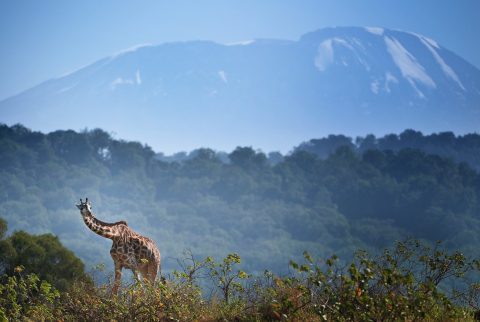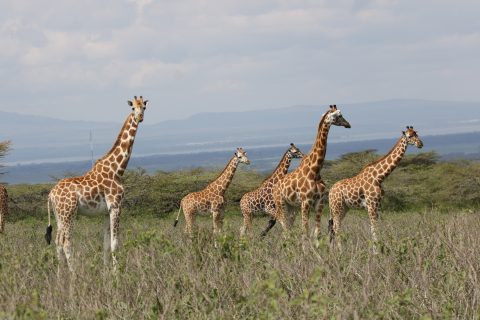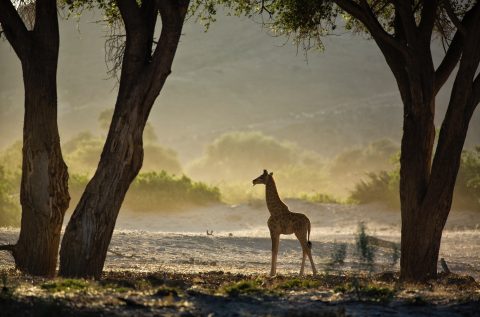Posted In Conservation | 11th July 2023
Standing Tall: A Conversation with the Giraffe Conservation Foundation
They’re one of the most recognisable animals in the animal kingdom, with their record height and unmissable spots.…but did you know the beloved giraffe is in trouble? We sat down with Stephanie Fennessy, Executive Director of the Giraffe Conservation Foundation (GCF), who Dublin Zoo have been supporting since 2012, to find out more about these majestic animals, and what they are doing to save them.
‘There’s only about 117,000 giraffes remaining in all of Africa’, Stephanie tells Dublin Zoo. She continues, ‘if we compare that number to elephants, for example, there are about 450,000 elephants remaining in Africa, meaning there’s only one giraffe for every four elephants.’
Since its beginnings in 2009, GCF’s mission has been to be a voice for giraffes. Stephanie, her husband Julian, and the entire GCF team, are dedicated to creating a sustainable future for all giraffe populations in the wild. Their work focuses on identifying the pressures facing giraffe, finding ways to support the conservation of existing giraffe habitats, and raising awareness of the key role these species play in the wild.
‘The threats giraffes are facing are not so different to those facing all wildlife. It’s mostly loss of habitat, fragmentation of habitat, and habitat degradation – there’s just less and less space for animals because people need more space for agriculture, to live and to build roads and other infrastructure’, Stephanie explains. ‘This activity is dissecting their habitat and resulting in the decline in giraffe numbers that we are seeing today’.

It is estimated that 89% of giraffe habitat has been lost since the 1700s. As a result of this, a key operation carried out by GCF is translocation. As Stephanie explains, ‘in Africa, there are a lot of areas where giraffes have gone locally extinct, for various reasons such as habitat loss or poaching. However, there is good news, as many of these are now safe again, and we can translocate giraffe to boost populations.’
For GCF, translocation is quite a high risk and fast-paced operation as they’re dealing with such immense animals, both in height and strength. ‘They’re just really, really, big and what a lot of people might not realise is that giraffes can kick in all directions – not just backwards and forwards but sideways too!’.
This movement of giraffes from one region to another has resulted in some amazing success stories. In 1997, the Uganda Wildlife Authority and the Kenya Wildlife Services teamed up to move three Nubian giraffes from Lake Nakuru National Park in Kenya to Kidepo Valley National Park. Twenty years later, when GCF led the first individual based photographic survey of giraffes in the region, they matched the spot patterns of photographs from the translocation to a large female, who they named Maggie. During their last survey, Maggie was spotted with a young calf. At the age of at least 25 years old, Maggie is one of the oldest known giraffes to give birth in the wild.
Being able to identify individual giraffe is another focus for GCF. For Stephanie, it’s something that brings her one of the greatest joys from her work. ‘I’ve worked in giraffe conservation for over 20 years, and I find recognising them individually so fascinating because the giraffe pattern is like a human fingerprint and when you know what a giraffe looks like you can recognise them. So, seeing a giraffe that we first studied 20 years ago and then to still see them present day roaming wild and free in Northwestern Namibia makes me very happy.’
GCF’s monitoring and observation of giraffes is not only focused on individual recognition and species tracking but also on developing a greater understanding of giraffes, their social structure, and behaviours. Despite being one of the most iconic species on the planet, there is still so much to learn about them. Stephanie describes giraffes as quirky, inquisitive, and always very aware of their environment. ‘With their great eyesight, they will see predators approaching from a far distance and we know that other animals that share their space keep a close eye on their activity because when a group of giraffes start moving at the same time, you can be sure that there’s something happening and should probably run too!’.

If you’ve ever wondered what the average day for a giraffe in the wild looks like, according to Stephanie, it involves ‘lots of walking, staring into the distance and of course, eating’. Feeding takes up most of a giraffe’s day, up to 75% at certain times of the year. They have a 45 – 50cm prehensile tongue (meaning it has strong muscular control, allowing them to grasp and hold things) that helps them get through the thorns and other defenses that shield their favourite food. But, surprisingly, despite their constant munching, they don’t require a lot of water, an adaptation Stephanie finds truly unique.
‘I find it really fascinating that such a huge animal is not reliant on water,’ she says. ‘In the area where we started our research in Northwestern Namibia, there is very little open water available, and we observed that giraffes get enough water from the food their consuming – like the leaves that still have that early morning dew on them. In almost seven years of research at the beginning, we never saw a giraffe drink! This why we started calling them ‘opportunistic drinkers’, because if there is water readily available, they will drink’.

Raising awareness of this, and more of giraffes’ wonders, is part of GCF’s ongoing work with local communities, governments and the wider world, as action is required now to save these species. ‘We need people to stand tall for these species, because I think it would be a really bad testament for humanity if giraffe were to go extinct under our watch.’
You can get involved with giraffe conservation by donating to organisations like GCF as Stephanie concludes, ‘giraffes can only be saved in Africa by African people, so in the end donating to organisations like the Giraffe Conservation Foundation really does help, because we work directly with African governments and people to provide education and research on the plight of giraffe and what actions can be taken to save them.’
Dublin Zoo’s support helps fund the work of the Nubian Giraffe Working Group, which is implementing the Recovery and Action Plan for Giraffe in Kenya.
For more information about the Giraffe Conservation Foundation and their work, please visit their website.
The images and video included in the article are courtesy of the Giraffe Conservation Foundation.
